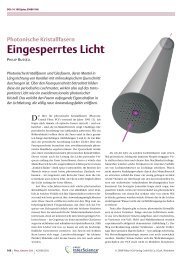Diploma thesis
Diploma thesis
Diploma thesis
You also want an ePaper? Increase the reach of your titles
YUMPU automatically turns print PDFs into web optimized ePapers that Google loves.
a nonlinear, nonmagnetic material, that is free of charges and currents:<br />
−∇ 2 � E + 1<br />
c 2<br />
∂2 ∂t2 � E = − 4π<br />
c2 ∂2P� . (3.1)<br />
∂t2 For dispersive nonlinear materials and three interacting waves, this equation can be<br />
solved with a quasi-monochromatic Ansatz, and yields the intensity of the upconverted<br />
field [14]:<br />
I3(ω3) = (2π)524χ (2) 2<br />
123 I1(ω1)I2(ω2)<br />
n1n2n3λ2 3c L 2 sinc 2<br />
� �<br />
∆kL<br />
. (3.2)<br />
2<br />
Equation 3.2 describes the coupling between the three involved fields. The efficiency<br />
of SFG depends on the momentum mismatch ∆k, between the interacting waves,<br />
where we assume strictly collinear waves propagation.<br />
∆k = k3(ω3) − k2(ω2) − k1(ω1). (3.3)<br />
Only if the combined momentum of all involved photons equals zero an efficient SFG<br />
is possible. The Sellmeier equations or refractive indices for the crystal therefore have<br />
to fulfil Eq. 3.4 under the restrictions of energy conservation (ω3 = ω2 + ω1).<br />
n1ω1 + n2ω2 = n3ω3<br />
(3.4)<br />
The coupling constant of the three interacting waves with different polarizations,<br />
in SFG, is given through the χ (2)<br />
ijk-tensor. In lossless crystals, this tensor can be<br />
reduced to a two dimensional matrix dij because of crystal symmetries [14].<br />
⎛ ⎞<br />
⎛<br />
⎝<br />
Px<br />
Py<br />
Pz<br />
⎞<br />
⎛<br />
⎠ = ɛ0 ⎝<br />
d11 d12 d13 d14 d15 d16<br />
d21 d22 d23 d24 d25 d26<br />
d31 d32 d33 d34 d35 d33<br />
(Ex) 2<br />
(Ey) 2<br />
(Ez) 2<br />
⎞ ⎜ ⎟<br />
⎜ ⎟<br />
⎜ ⎟<br />
⎠ · ⎜ ⎟<br />
⎜<br />
⎜2EyEz<br />
⎟<br />
⎝2EzEx<br />
⎠<br />
2ExEy<br />
(3.5)<br />
The fields EiEj on the right hand side of equation 3.5 are the incoming pump fields.<br />
They introduce a nonlinear polarization Pi, that emits a SFG field with the same<br />
polarization, but a different frequency. In common nonlinear materials numerous<br />
coupling constants dij are close to zero, and only a small number of possible threewave-interactions<br />
remains. In the case of orthogonally polarized incoming pump<br />
fields, this is called type-II SFG. Identically polarized pump waves are denoted by<br />
type-I SFG.<br />
Equation 3.2 still lacks the consideration of polychromatic waves, common for<br />
pulsed laser sources. Hence, we generalize equation 3.2 to describe one broadband<br />
laser pulses propagating through the crystal. The pulse exhibits a Gaussian shape<br />
in the frequency domain, as follows:<br />
6<br />
I ′ (ω−ωp)2<br />
−<br />
2σ<br />
p(ω) = Ipe 2 p (3.6)



